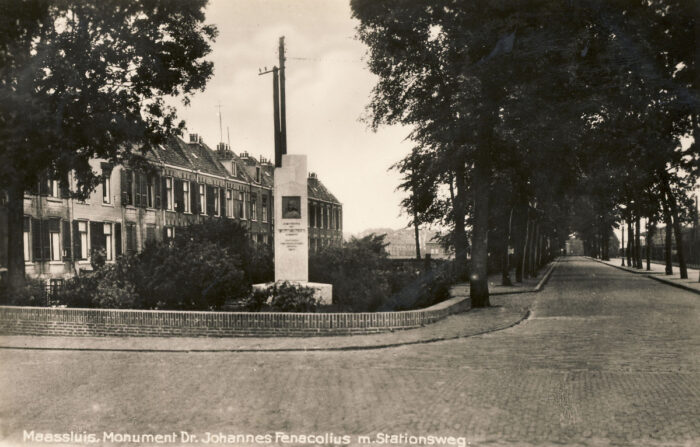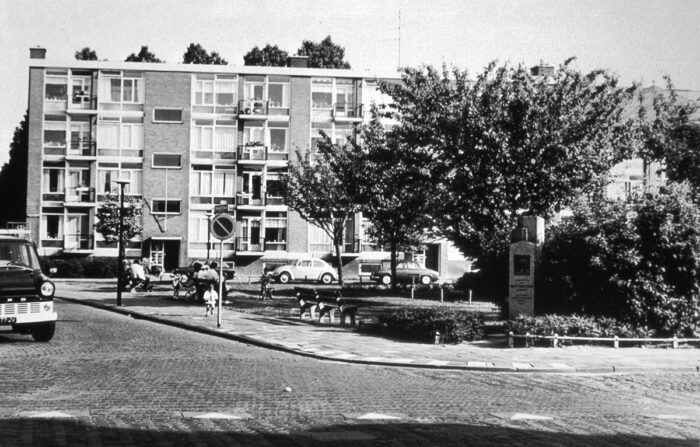
Het monument aan het Havenplein
The monument at the Havenplein

Het monument aan het Fenacoliusplein
The monument at the Fenacoliusplein
Dominee Johannes Fenacolius was een van de belangrijkste personen uit de historie van Maassluis. Hij heeft ervoor gezorgd dat Maassluis in 1614 een zelfstandige gemeente werd. Voor die tijd hoorde het vissersdorp Maeslantsluis bij de gemeente Maeslant, een dorp dat 4 km verderop ligt. Daar zat het gemeentebestuur, de schout, de notaris, de deurwaarder en het rechthuis. Voor elk wissewasje moesten die uit Maeslantsluis dus op en neer lopen naar Maeslant. Erger nog was de onrechtvaardige verdeling van de ontvangsten en uitgaven. De belastingopbrengst van de vissers verdween in een schijnbaar bodemloze put, Maeslantsluis zag er niets van terug. Dat de vissers vooral protestants waren en de agrariërs in Maeslant vooral katholiek, werkte ook al niet mee. Kortom, de twee gemeenschappen hadden voortdurend wrevel en conflict.
Jarenlang duurde de onderlinge strijd. Er werden veel brieven geschreven en diplomatie bedreven. Daar bleken de Maeslantsluizers beter in. Zij hadden sinds 1608 dominee Fenacolius als predikant in hun midden. Hij was een geleerd man, kon schrijven als de beste en wist als jurist slim om te gaan met conflicten. Hij had directe toegang tot de regering van het land. Hij was bevriend met raadspensionaris (wij zouden zeggen: minister-president) Johan van Oldenbarnevelt. De strijd werd beslist in het voordeel van Maeslantsluis. De Staten van Holland gaven het dorp de felbegeerde zelfstandigheid. Onder de naam Maassluis lag het vanaf 1614 tot 1891 als een enclave binnen het grondgebied van Maeslant. Pas daarna kon Maassluis gaan groeien…
Onder Fenacolius groeide de kerkelijk gemeente in de stad. Het kerkje uit 1598 werd te klein op den duur te klein. Rond 1620 ontstond het plan tot het bouwen van een grotere kerk. Fenacolius werd de drijvende kracht achter de bouw van de Groote Kerk Die verrees tussen 1629 en 1639 op de Schans, een buitendijks gelegen eiland. Fenacolius wijdde de kerk in op 9 oktober 1639.
Het monument voor ds. Fenacolius werd in 1933 geplaatst op het Havenplein, aan het westelijk einde van de Fenacoliuslaan. Rond 1955 werd het verplaatst naar het Fenacoliusplein en in 2015 werd het op de huidige plaats gezet. Dominee Fenacolius staat eindelijk op een plek waar hij het oude stadje kan overzien dat hij 400 jaar eerder wist los te maken.
++++++++++++++++++++
FENACOLIUS MONUMENT
Reverend Johannes Fenacolius was one of the most important persons in the history of Maassluis. He ensured that Maassluis became an independent municipality in 1614. Before that, the fishing village of Maeslantsluis belonged to the municipality of Maeslant, a village that is 4 km away. The municipal council, the sheriff, the notary, the bailiff and the courthouse were there. For every trifle, those from Maeslantsluis had to walk up and down to Maeslant. Worse still was the inequitable distribution of revenue and expenditure. The tax revenue of the fishermen disappeared in an apparently bottomless pit, Maeslantsluis saw nothing of it. The fact that the fishermen were mainly Protestant and the farmers in Maeslant mainly Catholic did not help either. In short, the two communities had constant resentment and conflict.
The controversy went on for years. Many letters were written and diplomacy practiced. The Maeslantsluizers turned out to be better at this. Since 1608 they had Reverend Fenacolius as pastor in their midst. He was a learned man, a man of letters and as a lawyer he knew how to deal with conflicts cleverly. He had direct access to the government of the country. He was friends with Grand Pensionary (we would say: Prime Minister) Johan van Oldenbarnevelt. The battle was decided in favour of Maeslantsluis. The States of Holland gave the village the much desired independence. Under the name Maassluis it was an enclave within the territory of Maeslant from 1614 to 1891. Only then could Maassluis start to grow…
Under Fenacolius, the ecclesiastical community in the city grew. The church from 1598 became too small in the long run. Around 1620 the plan arose to build a larger church. Fenacolius became the driving force behind the construction of the Groote Kerk – Great Church –, which was built between 1629 and 1639 on the Schans, a formerly fortified island located outside the dikes. Fenacolius dedicated the church on October 9, 1639.
The monument to Rev. Fenacolius was placed in 1933 on the Havenplein, at the western end of the Fenacoliuslaan. Around 1955 it was moved to Fenacoliusplein and in 2015 it was put in its current location. Reverend Fenacolius is finally in a place where he can survey the old town he succeeded to set free 400 years earlier.

Het monument aan het Havenplein
The monument at the Havenplein

Het monument aan het Fenacoliusplein
The monument at the Fenacoliusplein